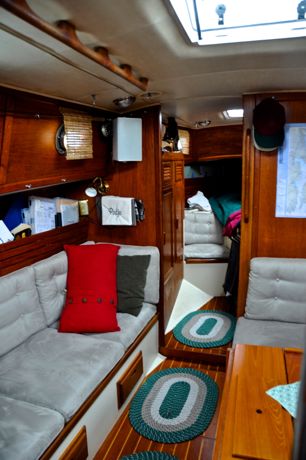It's Friday April 19, 2024
News From The Village Updated Almost Daily

Lots of boats come to Oriental, some tie up at the Town Dock for a night or two, others drop anchor in the harbor for a while. If you've spent any time on the water you know that every boat has a story. The Shipping News on TownDock.net brings you the stories of the boats that have visited recently.
March 30, 2013
David Gow is well familiar with time — both as a concept — and a hands-on thing. He has made a career of restoring antique clocks. As Conservator for the Willard Clock Museum in Grafton, Massachusetts he’s around valuable old timepieces all the time. Right now, David Gow is taking time for a dream he’s had for 20 years – to go off on a sailboat, point it south and head to the islands for a year.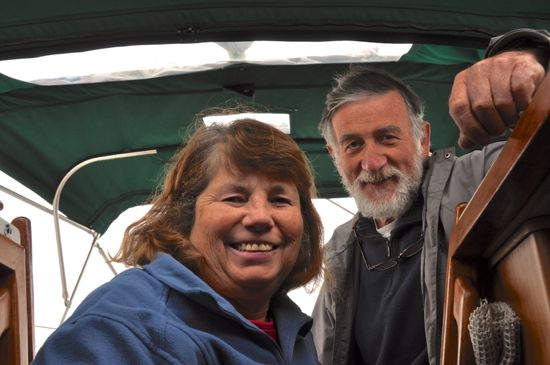 David and Barbara Gow on board their Pacific Seacraft 37, Podjo.
David and Barbara Gow on board their Pacific Seacraft 37, Podjo.Though David Gow and his wife, Barbara had sunny islands in mind when they set out from Narragansett Bay in October, it was two islands much closer to home that gave them tales to tell by the time they reached Oriental in November.
At that point, they’d hoped to be further south than the Town Dock, where they were tied up “Podjo” their Pacific Seacraft 37 for a few days. But five weeks in to their cruising, they were beginning to absorb a lesson about the way boats and weather can conspire against schedules. One of the instructors went by the name Sandy.
After a few delays in taking off from their home waters in Rhode Island, the Gows in late October were sailing down the Long Island Sound when they detected a small issue with a sail. They decided to seek out a repair at City Island, a small village on the far northeastern edge of the Bronx and New York City.
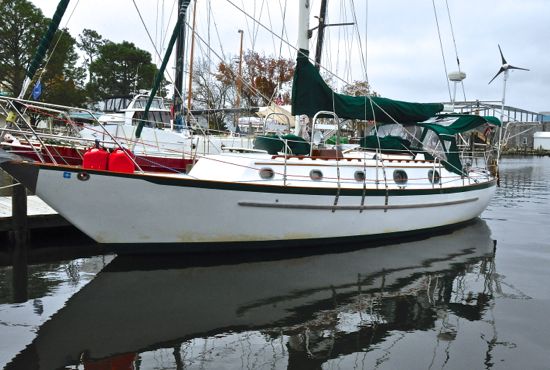 Podjo at Oriental’s Town Dock when David and Barbara Gow stopped in to catch their breath on the way south in November.
Podjo at Oriental’s Town Dock when David and Barbara Gow stopped in to catch their breath on the way south in November.About this same time, it was looking as if Hurricane Sandy would be approaching in a day or two. Their grown sons were phoning them, concerned, to say they should get off the boat. David and Barbara set anchors and situated their new home in the lee of Hart Island, a few thousand feet from City Island.
Then, they tried to dinghy to City Island, David Gow remembers. “I was fairly nonchalant.” But not for long. Even with an engine on the skiff the going was slow. They were only half way to the shore, and in the late afternoon, darkness and rougher seas were setting in. “It took all of our effort.” David says. He recalls thinking, “‘This is going to be a headache.‘”
“Waves were lashing over us,” David says. But cutting across the rollicking water was just one part of the challenge for the new cruisers. As they got closer to the City Island shoreline, they saw nowhere to get ashore. There was one dock, but it was towering over them, revealing pilings encrusted in menacing barnacles.
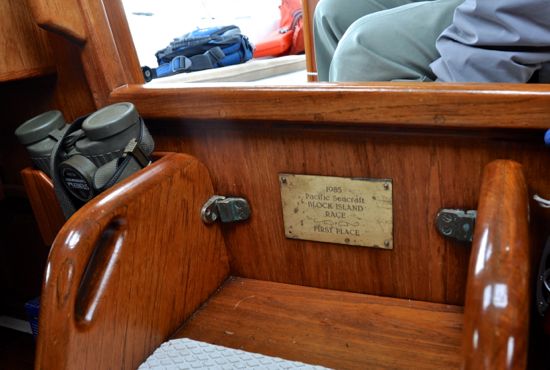 Another island story for “Podjo”. The Plaque on her companionway says that the boat took first place in the 1985 Pacific Seacraft Block Island Race.
Another island story for “Podjo”. The Plaque on her companionway says that the boat took first place in the 1985 Pacific Seacraft Block Island Race.Then came the first of several City Island encounters that saved the day. David says “two young guys were signaling to us to go over to the side.” The young men threw a line down to the Gows who, somehow, used that to climb up on to the dock. Their dinghy was hoisted up after them.
By this point, it was pitch black, and the Gows were sopping wet. “soaked, miserable, cold and stringy,” by their description. David and Barbara found empty streets and as they walked around in the chill, wet, dark night could find no hotel. With the hurricane bearing down toward New York and only them and the police on the streets of City Island, David says they felt “like vagrants.”
There was one place open. A pub, and they went inside for the chance to warm up and dry out. They still had no sense of where they could stay for the night. After a while, Barbara says, “A woman comes up to us and after chatting with the fellow at the bar, she said, ‘We have a basement room where you can stay.‘”
The man was a fireman in the Bronx, Barbara says, and “they couldn’t do enough for us.” The Gows rode out Hurricane Sandy there and stayed for a couple of nights. Meanwhilel, “Podjo” rode out the hurricane just fine in her holding near Hart Island where they stayed for a few days more.
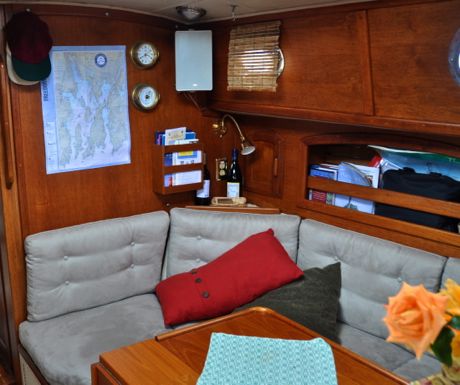 Back to the comforts of “Podjo”.
Back to the comforts of “Podjo”.Hart Island fascinated them, David in particular, and even though they never set foot on it as it’s off-limits to the public, he was still speaking glowingly of it, weeks later in Oriental. Over the centuries, Hart Island has been the site of POW camps, from both the Civil War and WWII. It’s housed a prison, a reformatory.
Perhaps even more memorably for the crew of Podjo, it is a Potter’s Field, the final resting place for New Yorkers whose families wouldn’t pay to bury them, or who died alone. An estimated 800,000 bodies are buried there, their coffins stacked one atop the other in long trenches.
The burials go on to this day, as the Gows were to see. Anchored a stone’s throw from the shore, they watched daily as a ferry brought prison inmates to Hart Island to bury more dead. The Gows were anchored so close, they say, that they could hear the taunts from the inmates, ‘We can see you! We can see you!‘”
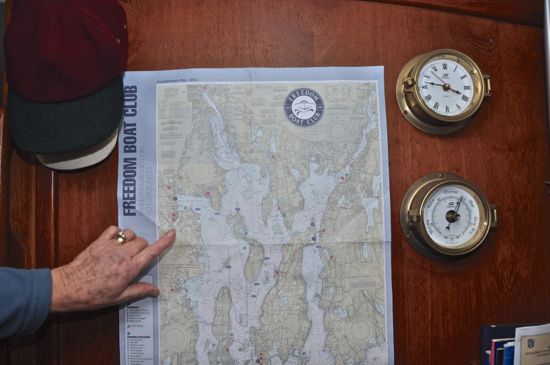 On board “Podjo” the clock just tells time, David Gow says. Barbara Gow points to the home waters for “Podjo” on Narragansett Bay. That’s where they sail actively through the summer months. Their voyage south on “Podjo” is part of an 8 month trip to the islands.
On board “Podjo” the clock just tells time, David Gow says. Barbara Gow points to the home waters for “Podjo” on Narragansett Bay. That’s where they sail actively through the summer months. Their voyage south on “Podjo” is part of an 8 month trip to the islands.Still, they stayed, and besides the activity of the inmates, the Gows say they watched all sorts of wildlife on the island where so many dead are buried. The irony they say, is that they were “finding life there.”
[page]
Once their sail was repaired, they turned southward again, sailing down the East River, and past lower Manhattan. A few miles south of the Veranzzano Bridge, they took their head sail down. Which would have been uneventful if the jib sheet hadn’t traipsed overboard and lurked in the water, just waiting for them to crank the engine.
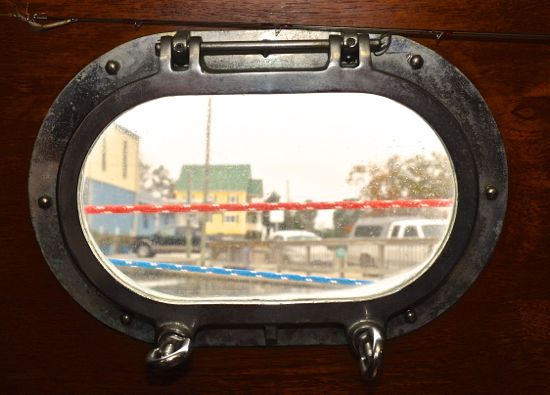 Changing scenes outside the portlights on “Podjo”. A few weeks earlier it looked out on Hart Island where 800,000 people are buried. Then on the Verranzano Bridge. In late November, it afforded a vista of a town of 900.
Changing scenes outside the portlights on “Podjo”. A few weeks earlier it looked out on Hart Island where 800,000 people are buried. Then on the Verranzano Bridge. In late November, it afforded a vista of a town of 900.That’s when the “jib sheet wrapped around the prop and the engine stalled. So now, not only don’t we have an engine but we don’t have a headsail.” Tucking in to Sandy Hook would have meant “tacking with the mainsail and the staysail,” David says, “and I didn’t have the energy.”
Instead, David says, “I went overboard,” The seas were 4+ feet and it was a half hour before dark. “I’m down there with a mask trying to get this jib sheet untangled from the prop and the boat’s bounding around and the Veranzano Bridge is up there, kind of a looming thing.”
Barbara saw one advantage in that. The bridge, a few miles away, “helped keep our orientation of where we were.”
But in the moment, David had a less optimistic take that “this is going to be the end for sure.”
A week earlier they’d found themselves on the deserted streets of City Island, cold and in the dark. Now he was cold and dark and the not-so-warm waters south of the Verranzano. On top of that, his efforts were for naught. “I couldn’t get anything untangled.” So he came up out of the water and in to Podjo’s salon.“I shivered down there for an hour. I was cold. Uncontrollably…” Traces of his native Aberdeen provide the emphasis in each syllable.Salon on Podjo. It was refuge from the weather after a person has been immersed in waters approaching New York’s harbor.Once he got revived, he and Barbara decided to just keep “Podjo” sailing along the Jersey shore to Atlantic City. And so with a sheet wrapped around the prop, and with a head wind, the crew of “Podjo” made what would be their first overnight passage.
The next afternoon, they were sailing in to Atlantic City, the jib line still tautly attached to the prop. Once in the anchorage, David plunged in to the water for the second time in a day. “We needed that motor, so I had to go over again,” he says. “At least it was daylight.”
They had relatively smoother sailing after that. By the time they got to Oriental, the memories were warm ones – of the kindnesses on City Island, and making that first – unplanned – overnight passage on the Jersey shore, and being treated well along the way. What is the expression, David asks. “You got to kiss a frog to get a prince?”
The Gows have owned Podjo for about three years. The name comes from New Orleans, and roughly, means “friend.” It came with the Pacific Seacraft 34. “We’re never good at naming things,” they say.
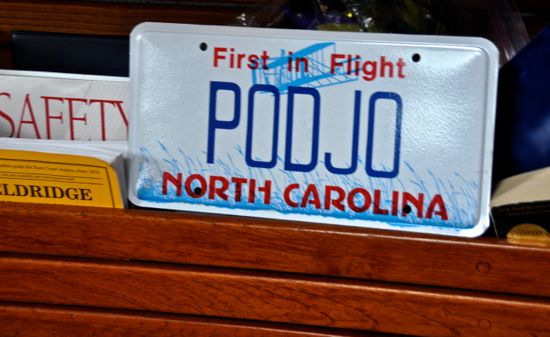 Boat with license plate.
Boat with license plate.For “Podjo” the Gow’s stop in Oriental was a homecoming. “Podjo” had previously belonged to Beth Schwartz who used to work at Triton Yachts, and her husband Neal. They are known for keeping their boats spotless. That was not lost on the Gows as they sailed down the ICW and neared Oriental.
They were coming down the Pamlico Sound, on a fine beam reach a few miles out of Oriental, when David decided that maybe they ought to “swab the decks a bit.” And there he was, swabbing, the boat on auto pilot. His phone rang. He took the call. It wsa someone with a question about the clock he’d worked on in the gallery of the US Capitol. (A clock that he notes, runs five minutes fast.) The phone call ran longer than that and when it was over, David says a check of the chart plotter showed that they’d gone two miles past Oriental.
They stayed at the Town Dock for a few days, and took stock. The trip south was taking longer than they’d planned but they were adjusting. Barbara was candid about the sometimes rough going. A recently retired obstetrics nurse, she says they were planning to be back at home in Massachusetts in May.
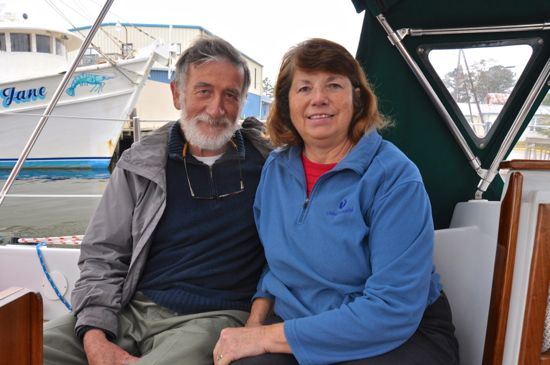 David and Barbara Gow aboard “Podjo” at Oriental’s Town Dock.
David and Barbara Gow aboard “Podjo” at Oriental’s Town Dock.Twenty years ago, she and David learned to sail together, with their then young boys. They spent many weekends sailing on Narragansett Bay. But this idea of leaving land and home behind to live on a boat? That, says Barbara Gow, was David’s dream..“I’m kind of going along with it.”
“She’s doing pretty good,” David says, as encouragement.
“I’m coping.” She answers.
“Yeah, she is.”
Still, Barbara speaks brightly of the people they encountered as they got their late start toward the islands. They are people, she says, they wouldn’t have otherwise met. Sometimes, it just takes time…
